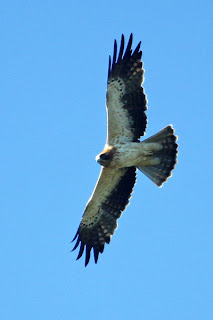It was still early when we crossed the Ribeira do Vascão that forms the border between the Algarve and the Baixo Alentejo. And it was cold! And, worse still, it was foggy!
An hour or more later, it was still fairly murky when we encountered the first of the day’s notable birds, two Spanish Imperial Eagles (Spimps as we call them), presumably a pair. The difference in size between the two of them was immediately obvious, as was their behaviour; the larger female quickly took flight but the male seemed quite relaxed and waited several minutes before joining her, giving us chance to grab a few photographs as it remained perched on a power pole.
Spanish Imperial Eagle is one of the world’s rarest raptor species but the frequency with which we see them in the Alentejo has increased to the point where we now come away disappointed if we don’t come across them. In 1974 the population had fallen to only about 50 pairs (all in Spain) and the outlook was grim but since then there has been a remarkable recovery with more than 250 territories now occupied. This increase has seen the birds re-colonise Portugal and several pairs are now reported to be breeding here with others wandering across the border in the autumn from the species’ stronghold in Extremadura.
The Species action plan for the Spanish Imperial Eagle commissioned by the European Union has as its goal the restoration of the population to a favourable conservation status; its target is to ensure a stable or increasing population of at least 1,000 mature individuals by 2018. It would be marvellous to think that could be achieved.
Our objectives for the day were certainly met as we climbed to a new (for us) raptor watchpoint, located the site of a Lesser Kestrel colony that will give us another option for seeing these birds when they return and finally looked in more detail at an area that we regularly pass through where we have often seen Golden Eagles.
Bustard country
We very much enjoy the wetlands of the Ria Formosa with their Greater Flamingos, waders and gulls but it's very nice to have the wide open spaces of the Alentejo as an alternative for a day out within easy reach of our base in Tavira.



































